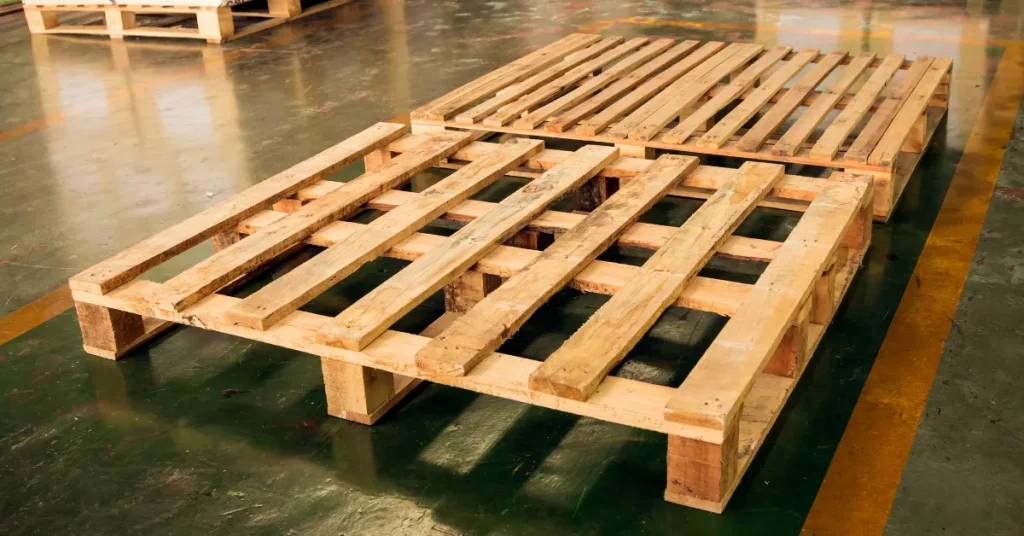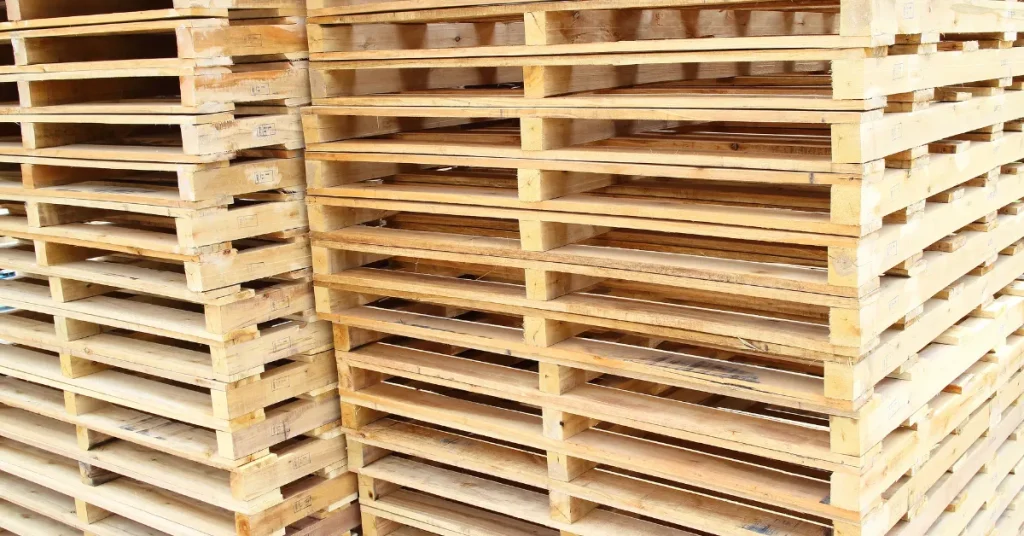A standard wood pallet’s thickness typically ranges from 5 to 7 inches. It depends on the specific design and intended use of the pallet.
Pallets are essential components in the shipping and warehousing industries, serving as sturdy platforms for storing and transporting goods.
Their robust construction enables them to support significant weight, which is vital for logistics and supply chain operations. Commonly made from wood, pallets need to maintain a balance between strength and weight to be effective.
The thickness of a wood pallet, therefore, plays a crucial role in ensuring it can withstand loads while remaining maneuverable.
Manufacturers design various types of pallets to cater to diverse requirements, leading to some variation in dimensions and capacities.
Hence, when considering pallet options, it’s important to select one with the appropriate thickness that aligns with the operational needs of your business.

The Essential Role Of Wood Pallets
Wood pallets play a crucial role in our global economy. They are the unsung heroes that make it possible for goods to travel safely from manufacturers to store shelves.
Despite their simple appearance, these structures are engineered to bear heavy loads while being easy to transport.
The thickness of wood pallets ensures durability, making them a staple in storage and delivery processes worldwide.
Pallets In The Global Supply Chain
Wood pallets are fundamental to the logistics industry, acting as the base for the movement of products.
- Standard sizes allow for efficient handling and storage.
- Pallets optimize loading, reducing shipping costs.
- Durable construction supports various weights and sizes of cargo.
Pallets function as the building blocks of the global supply chain, enabling goods to reach all corners of the world.
Sustainability And Recycling Potential
Wood pallets offer a green solution to transport logistics. Their potential for recycling and sustainability is significant.
- Recyclable material means pallets can be repurposed into new products.
- Pallets reduce waste in the supply chain, endorsing eco-friendly practices.
- Repairable features prolong their lifecycle, limiting environmental impact.
Wood pallets not only support the weight of commerce but also promote a cycle of renewal and reuse.
Standard Sizes And Dimensions
Understanding the standard sizes and dimensions of wood pallets is key for efficient storage and shipping.
A pallet’s thickness varies but it must support heavy loads. Commonly used dimensions facilitate the easy handling, transportation, and stacking of goods.
Iso Pallet Size Specifications
The International Organization for Standardization (ISO) sets criteria for pallet dimensions. These sizes ensure compatibility with international shipping containers.
| ISO Size | Dimensions (W x L) |
| ISO1 | 1219 x 1016 mm |
| ISO2 | 1200 x 1000 mm |
| ISO3 | 1219 x 1219 mm |
| Others | Vary in size |
Different regions may prefer particular ISO sizes. North America often uses ISO1, while Europe opts for ISO2.
Common Variations Across Industries
Different industries use pallets suited to their needs. These variations ensure optimal space utilization and product safety.
- Pharmaceutical Industry: Often requires smaller, more hygienic pallets.
- Food Industry: Prefers pallets that support cold storage and easy cleaning.
- Construction Industry: Uses thicker, more robust pallets for heavy materials.
Pallet thickness is crucial for material handling equipment. Thicker pallets typically measure between 40 mm to 120 mm in height.
Measuring Pallet Thickness

When working with wood pallets, knowing their thickness is key. Pallet thickness can affect how much weight they can carry.
It can also impact how they stack during shipping and storage. We will look at how to accurately measure this important aspect of pallets.
Technical Aspects Of Pallet Design
Pallets must be strong and durable. The wood used must withstand heavy loads and frequent use. Different pallet designs have varying dimensions.
Standard pallet thickness usually ranges from 1.4 inches (35 mm) to 1.8 inches (45 mm). Pallet strength also depends on the wood quality and the type of nails or staples used.
- Stringer Pallets: Usually have thicker dimensions due to their design.
- Block Pallets: These may be slightly thinner but still maintain strength due to their structure.
Tools For Accurate Measurement
To ensure you get precise thickness measurements of a pallet, you need the right tools. A caliper is one of the most accurate tools for this purpose.
If a caliper is not available, a standard ruler or measuring tape can also do the job. Ensure the tool is placed squarely across the wood for a correct reading.
- Caliper: For precise measurements.
- Ruler/Tape Measure: For general measurements.
| Pallet Type | Typical Thickness (inches) |
| Stringer Pallet | 1.4 – 1.8 |
| Block Pallet | 1.4 – 1.8 |
Factors Influencing Pallet Thickness

Understanding the thickness of wood pallets is vital for diverse applications. Factors such as material choice and load capacity play pivotal roles.
Knowing these can ensure optimal performance and safety. Let’s explore how these factors influence pallet thickness.
Material Selection
The type of wood used in pallet construction significantly impacts thickness. When selecting materials, two common categories emerge:
- Hardwood: Typically denser and may require thinner cuts for similar strength.
- Softwood: Often thicker to compensate for lower density and ensure durability.
Manufacturers also consider wood’s grain quality and moisture content. These affect the pallet’s final thickness and strength.
Load Capacity Requirements
Pallets must withstand certain loads. The required load capacity dictates the ideal thickness. Consider the following:
| Load Type | Typical Thickness (Inches) |
| Light Duty | 0.375 – 0.625 |
| Medium Duty | 0.625 – 0.875 |
| Heavy Duty | 0.875 – 1.5 |
Heavier loads demand thicker boards and sturdier construction, influencing the pallet’s final dimensions.
Implications Of Thickness On Pallet Use
Understanding the thickness of wood pallets is crucial. It affects how they perform in various scenarios. From shipping costs to durability, the thickness of the pallet can make a significant difference in logistics.
Impact On Shipping Costs
Thicker pallets often mean heavier pallets. This directly influences freight charges. Shipping companies typically calculate costs based on weight and dimension.
As the thickness increases, so do the weight and consequently, the shipping expense.
- Weight-based pricing: Thicker pallets can increase total shipment weight.
- Dimensional weight pricing: Pallet dimensions can lead to higher costs even if the actual weight is low.
Pallets that are excessively thick may result in fewer units per shipment. This reduces space efficiency and could require additional transport.
Durability And Life Span
Pallet thickness can be a key factor in determining how long they last. Increased thickness can mean a better ability to withstand wear and tear. This is essential for heavy-duty applications.
| Thickness | Durability | Life Span |
| Less Thick | Decreased | Shorter |
| More Thick | Increased | Longer |
However, overly thick pallets may not be cost-effective for all users. They require more material to produce and can lead to higher initial investment.
FAQs About How Thick Is A Wood Pallet
How Thick Is A 48×40 Pallet?
A standard 48×40 pallet typically has a thickness of approximately 6 inches.
What Size Is A Wooden Pallet In Inch?
The standard size of a wooden pallet in the United States is 48 inches long by 40 inches wide. Other sizes are also common, depending on the industry and use.
How Much Does A 4 Foot Pallet Weigh?
A standard 4 foot wooden pallet typically weighs between 30 to 48 pounds.
What Size Is A Large Wooden Pallet?
A standard large wooden pallet typically measures 48 inches by 40 inches.
Conclusion
Understanding the thickness of wood pallets is crucial for logistics, safety, and durability in shipping. Standard pallets typically measure about 5 inches thick.
This knowledge ensures proper equipment selection and cargo load planning. Remember, always check the specifications for your specific needs to maintain optimal operational efficiency.
Resources:
1. https://www.aphis.usda.gov/aphis/ourfocus/planthealth/import-information/wood-packaging-material
